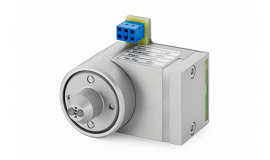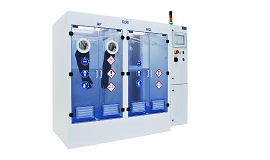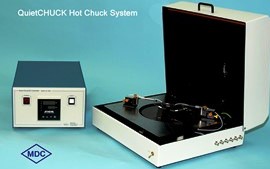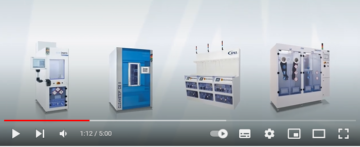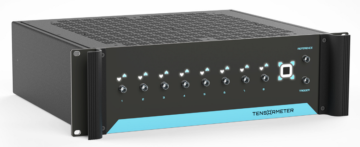MDC TECHNICAL NOTE
MERCURY PROBES – IDEAS FOR BETTER MEASUREMENTS
Introduction
The MDC Mercury Probe is a fast, convenient tool to make measurements on semiconductor structures. However, inaccuracies in the measurements can occur if certain precautions are not taken. This technical note will discuss some of the most common problems associated with the use of the Mercury Probe and look at suggested remedies.
Basic Probe Operation – Measurement Platform
To understand some of the problems that can occur while using the Mercury Probe, it is helpful to understand how the MDC Mercury Probe works. The MDC Mercury Probe system is made up of a measurement platform, valve assembly, and a vacuum source. The measurement platform has two glass vials under it that contain mercury. Mercury is pushed to the surface of the platform to contact a sample. The surface of the platform is machined flat and then lapped to give a texture to allow a vacuum leak between its surface and the sample under test.
In the center of the measurement platform is a small hole surrounded by an open annulus. These are surrounded by a continuous annulus. The center hole is the main mercury contact capillary. The open annulus is a secondary mercury contact. It can serve as a return contact or a guard ring contact. Both of these mercury contacts are connected to the vials containing mercury via two stainless steel capillary tubes. The outermost annulus is the vacuum ring. These components form the active region of the Mercury Probe.
To control the flow of mercury to the contacts, vacuum is used. There are two vacuum lines that connect the measurement platform to the valve assembly that controls the vacuum. One vacuum line connects to the vacuum ring and the other connects to the mercury vials. The vacuum line connecting to the vacuum ring makes the mercury come into contact with the test sample by reducing the pressure at the sample. The pressure differential with the atmosphere then pushes mercury in contact with the sample.
NOTE: The annular mercury contact ring is not continuous. If it were, vacuum could not reach the center mercury capillary. A complete outer ring would prevent the mercury dot from being drawn into contact with the sample.
There are two additional glass vials on the bottom of the probe. These are mercury traps and are placed between the platform and the valve assembly. These vials trap mercury before it enters the vacuum valve and vacuum system and they should normally be empty.
Basic Probe Operation – Vacuum Valve and Control Arm
The Mercury Probe control arm actuates the vacuum valve. This control arm has three positions that control different functions. When the arm is in the rear position, no vacuum is applied to the platform. The back contact arm is lifted to allow sample placement. This is the LOAD position.
When the arm is brought forward it passes through a vertical position. This is the PURGE position and vacuum is applied to the mercury vials to remove any mercury in the capillaries leading to the surface of the platform. In newer Mercury Probes, the back arm is lowered at this point to allow zeroing of the capacitance meter without turning off the vacuum.
In the third position, the control arm is all the way forward. This is the MEASUREMENT position. Vacuum is applied to the vacuum ring that draws the mercury up the capillaries and into contact with the sample.
After the measurement, the control arm is again moved to the LOAD position. It passes through the PURGE position, pulling the mercury back into the reservoir making sure that clean mercury is presented to the sample the next time a contact is made.
Mercury Probe Operation Hints
Now that the basic mechanisms of the Mercury Probe have been explained, more details can be given about ways to keep the probe operating at the highest level of accuracy.
1. Vacuum level: The vacuum level is critical to insure repeatable measurements. If the vacuum level is too great, the vacuum can overcome the surface tension of the mercury, pulling the mercury across the surface of the platform and causing distortion of the dot size. If the vacuum level is too low, the dot size will change with any small variations in the vacuum level.
The optimum vacuum level is 14 to 15 inches of mercury when using the factory supplied vacuum pump. If house vacuum is to be used, a regulator must be connected to adjust the level of vacuum. Because a greater volume of vacuum can be supplied by a house vacuum system, the optimum vacuum level should be set between 8 and 12 inches of mercury.
2. Platform Cleanliness: The measurement platform must be kept clear of contamination. If any particles are on the platform during a measurement, they can damage the platform or the sample, and not allow a good contact with the mercury. Removal of particles can be done with a compressed gas like dry nitrogen. If the platform needs to be cleaned, use only DI water or alcohol. The use of any other solvent could
damage the platform.
3. Mercury Cleanliness: The mercury must be clean also. It can pick up contaminants during the measurement process and it can oxidize. Check the mercury often by looking at it through the glass vials. It should have a shiny appearance without bubbles or the dullness associated with oxidation. Use only triple distilled, reagent grade mercury.
4. Mercury Life: The mercury should be changed periodically. If the probe is used constantly, consider changing the mercury weekly. If the probe is only used occasionally, change the mercury once a month.
If the Mercury Probe is beginning to leave drops of mercury on your sample or the platform, it is probably time to change the mercury. Dirty mercury tends to adhere to other surfaces because the high surface tension of the mercury is reduced.
5. Changing Mercury: When the mercury is changed, it is good practice is to place the probe in a tray that can catch any mercury drops that get loose. Remove the vials and use dry nitrogen to blow through the capillaries. This cleans out any contamination that can build up on the inside surface of the tubes. Be careful not to bend the tubes or scratch the surface of the platform. Also inspect the capillary tubes for excessive contamination. It may be easier to remove the top arm during this procedure.
6. Arm movement speed: The movement of the control arm can affect the accuracy of the measurement. If the arm is moved too quickly between the LOAD and MEASUREMENT positions, it will not allow for sufficient time to purge the mercury from the capillaries. This can allow contaminated mercury to float to the top of the mercury column and come in contact with the next sample measured. This will affect the contact area and give erroneous results.
Move the arm slowly from LOAD to MEASUREMENT or from MEASUREMENT to LOAD. It should take 2 to 3 seconds to move the arm through its range. This will give the probe enough time to purge the mercury from the capillaries.
7. Glass vial seals: Because the Mercury Probe uses a vacuum to operate, it is critical that no vacuum leaks occur. There is a small rubber O-ring inside the threaded area where the vials screw into the Mercury Probe. If during a mercury change, the O-ring is lost or damaged, a good seal cannot occur and the probe will either not work at all or work poorly.
8. Mercury level: There can be problems with Mercury Probe operation if the level of mercury is too low or too high. If the mercury level is too high, excess mercury can be left on the platform after a measurement or will be drawn into the traps during the purge cycle. If the mercury level is too low, intermittent contact can occur. The proper amount of mercury is 1.5 ml per vial. The best way to insure this measurement is to use a calibrated syringe or pipette.
9. Platform Texture: The texture of the platform is critical for accurate and repeatable measurements. After long use, the sliding of samples across the platform can wear down the texture and make it more difficult to pull a vacuum across the surface of the platform. If the platform becomes transparent, the surface is too smooth and needs to be renewed at the factory.
A scratched platform, especially near the mercury capillaries will reduce the repeatability of mercury probe measurements. Use care with wafer handling tools so they do not touch the platform. If the platform becomes scratched, it will have to be replaced or renewed at the factory. Sliding a wafer across the platform surface can alter the contact area. Therefore, when placing or removing a sample, it is best to position the sample over the platform before lowering into position. This will reduce any distortion of the measurement area and increase the lifetime of your measurement platform.
10. Dot size: The Mercury Probe measurement area is calibrated at the factory. Measuring the resistivity of a known standard with a uniform doping level allows this calibration. However, the area of the center dot can change with use. As samples are rubbed across the surface of the platform, they can enlarge the hole and increase the contact area. It is important to periodically calibrate the contact area. Refer to calibration information in your manual or contact the factory.
11. Stray capacitance: Stray capacitance can affect the accuracy of your measurements. Proper zeroing of the capacitance meter before a measurement is made can reduce these errors. To zero out most the stray capacitance, place the sample on the measurement platform and cycle the control arm once. With the arm back in the LOAD position, turn off the vacuum pump. Pull the control arm into the MEASUREMENT position and then zero the capacitance meter. If you have a newer Mercury Probe, the control arm lowers the back contact arm at the purge position. In this case, you can zero the capacitance meter in the PURGE position without turning off the vacuum pump.
There is still some stray capacitance that cannot be removed by this technique. This stray capacitance is caused by the interaction of the mercury after it is drawn up the capillaries. This capacitance can be corrected by measuring the resistivity profile of a known uniform sample. Since it is known that the doping is uniform, adjust the stray capacitance until the doping profile has no variation with depth.
NOTE: MDC CSM/Win Systems have the ability to replot a resistivity profile after changing the stray capacitance and device area in software. This allows for easy calibration of measurement area and stray capacitance.
12. Front-Front and Front-Back Measurement Configuration: Because there is a difference between the electrical area of a Mercury Probe calibrated in the Front-Front and Front-Back configurations, make sure that all measurements are done in the same configuration as the calibration. All probes are calibrated in the Front-Front configuration prior to shipment. The calibration sticker on the platform is labeled with an “F-F” to denote Front-Front calibration.
If a measurement is needed in the uncalibrated configuration, recalibrate the Mercury Probe area and stray capacitance in the new configuration before use.
13. Sample preparation – Si: If the sample measured is an N-type silicon epitaxial layer, it will require a passivation oxide to allow a good Schottky barrier to form. Boiling in DI water or just letting it sit around for a while will usually suffice. If the sample is a P-type silicon epitaxial layer, it will need to be freshly etched to form a good Schottky barrier. GaAs does not usually require any special sample preparation techniques.
14. Back Contact Preparation: If measurements are to be made using a Front-Back configuration, back contact resistance could adversely affect the measurement. Etching off any backside oxide from the wafer will help reduce the series resistance effect. If the sample is grown on a semi-insulating substrate, use the Front-Front configuration only.
15. Mercury Droplets: Mercury droplets left on the measurement platform can distort measurements by affecting device area or stray capacitance. Check the measurement platform often to check for mercury droplets. If mercury droplets are a constant problem, check that the mercury is clean, that the mercury vials are not too full, that the vacuum is at the proper level, that the platform has no damage and that the vacuum valve is not clogged.

